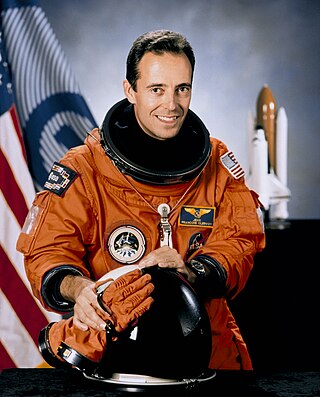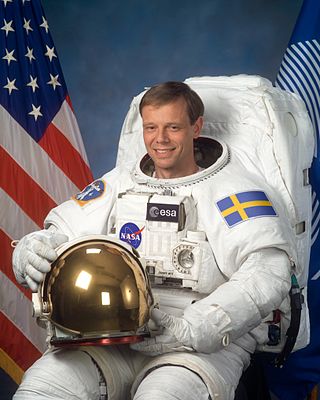
The European Space Agency (ESA) is a 22-member intergovernmental body devoted to space exploration. With its headquarters in Paris and a staff of around 2,200 people globally as of 2022, ESA was founded in 1975. Its 2024 annual budget was €7.8 billion.

Spacelab was a reusable laboratory developed by European Space Agency (ESA) and used on certain spaceflights flown by the Space Shuttle. The laboratory comprised multiple components, including a pressurized module, an unpressurized carrier, and other related hardware housed in the Shuttle's cargo bay. The components were arranged in various configurations to meet the needs of each spaceflight.

Ulf Dietrich Merbold is a German physicist and astronaut who flew to space three times, becoming the first West German citizen in space and the first non-American to fly on a NASA spacecraft. Merbold flew on two Space Shuttle missions and on a Russian mission to the space station Mir, spending a total of 49 days in space.

Jean-François André Clervoy is a French engineer and a CNES and ESA astronaut. He is a veteran of three NASA Space Shuttle missions.

Hans Wilhelm Schlegel is a German physicist, a former ESA astronaut, and a veteran of two NASA Space Shuttle missions.

STS-61-A was the 22nd mission of NASA's Space Shuttle program. It was a scientific Spacelab mission, funded and directed by West Germany – hence the non-NASA designation of D-1. STS-61-A was the ninth and last successful flight of Space Shuttle Challenger before the disaster. STS-61-A holds the current record for the largest crew—eight people—aboard any single spacecraft for the entire period from launch to landing.

Claude Nicollier is the first astronaut from Switzerland. He has flown on four Space Shuttle missions. His first spaceflight (STS-46) was in 1992, and his final spaceflight (STS-103) was in 1999. He took part in two servicing missions to the Hubble Space Telescope. During his final spaceflight he participated in a spacewalk, becoming the first European Space Agency astronaut to do so during a Space Shuttle mission. In 2000 he was assigned to the Astronaut Office Extravehicular Activity Branch, while maintaining a position as Lead ESA Astronaut in Houston. Nicollier retired from ESA in April 2007.

Yuri Pavlovich Gidzenko is a Russian cosmonaut. He was a test cosmonaut of the Yuri Gagarin Cosmonaut Training Center (TsPK). Gidzenko has flown into space three times and has lived on board the Mir and the International Space Station. He has also conducted two career spacewalks. Although he retired on July 15, 2001, he continued his employment by a special contract until Soyuz TM-34 concluded. Since 2004 to May 2009, Gidzenko was the Director of the 3rd department within the TsPK. Since May 2009 he serves as the Deputy Chief of Cosmonaut Training Center TsPK.

Soyuz TM-22 was a Soyuz spaceflight to the Soviet space station Mir. It launched from Baikonur Cosmodrome Launch Pad 1 on September 3, 1995. After two days of free flight, the crew docked with Mir to become Mir Principal Expedition 20 and Euromir 95. Mir 20 was a harbinger of the multinational missions that would be typical of the International Space Station. After 179 days, 1 hour and 42 minutes on orbit, Reiter obtained the record for spaceflight duration by a Western European.

Thomas Arthur Reiter is a retired European astronaut and is a Brigadier General in the German Air Force currently working as ESA Interagency Coordinator and Advisor to the Director General at the European Space Agency (ESA). He was one of the top 25 astronauts in terms of total time in space. With his wife and two sons he lives near Oldenburg in Lower Saxony.

The German astronaut team was established in 1987. Before the establishment of the team, then-West German astronauts were selected for single missions, or as part of the European Space Agency's crewed spaceflight activities. East Germany had its first cosmonaut, Sigmund Jähn; Jähn was both West and East Germany's first citizen in space when he departed from Baikonur in the Soviet Union in August and returned to Earth in September 1978. West and East Germany reunified in 1990 and the astronaut team became representative of a single German nation.

Arne Christer Fuglesang is a Swedish physicist and an ESA astronaut. He was first launched aboard the STS-116 Space Shuttle mission on 10 December 2006, making him the first Swedish citizen in space.
A mission patch is a cloth reproduction of a spaceflight mission emblem worn by astronauts and other personnel affiliated with that mission. It is usually executed as an embroidered patch. The term space patch is mostly applied to an emblem designed for a crewed space mission. Traditionally, the patch is worn on the space suit that astronauts and cosmonauts wear when launched into space. Mission patches have been adopted by the crew and personnel of many other space ventures, public and private.

NASA Astronaut Group 9 was a group of 19 NASA astronauts announced on May 29, 1980, and completed their training by 1981. This group was selected to supplement the 35 astronauts that had been selected in 1978, and marked the first time that non-Americans were trained as mission specialists with the selections of ESA astronauts Claude Nicollier and Wubbo Ockels. In keeping with the previous group, astronaut candidates were divided into pilots and mission specialists, with eight pilots, eleven mission specialists, and two international mission specialists within the group.

Jean-Loup Jacques Marie Chrétien is a French retired Général de Brigade in the Armée de l'Air, and a former CNES spationaut. He flew on two Franco-Soviet space missions and a NASA Space Shuttle mission. Chrétien was the first Frenchman and the first western European in space.

Euromir was an international space programme in the 1990s. Between the Russian Federal Space Agency and the European Space Agency (ESA), it would bring European astronauts to the Mir space station.

The 2022 European Space Agency Astronaut Group is the latest class of the European Astronaut Corps. The selection recruited five "career" astronauts as well as 12 "reserve/project" astronauts. They are the fourth European Space Agency (ESA) astronaut class to be recruited.





















